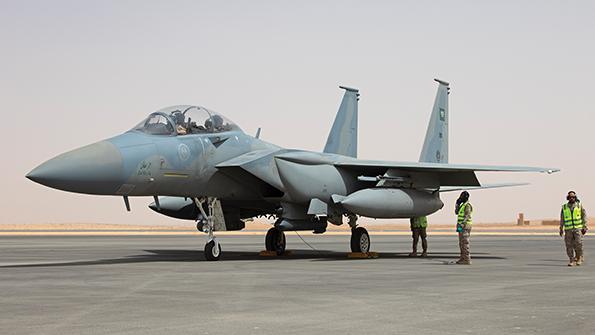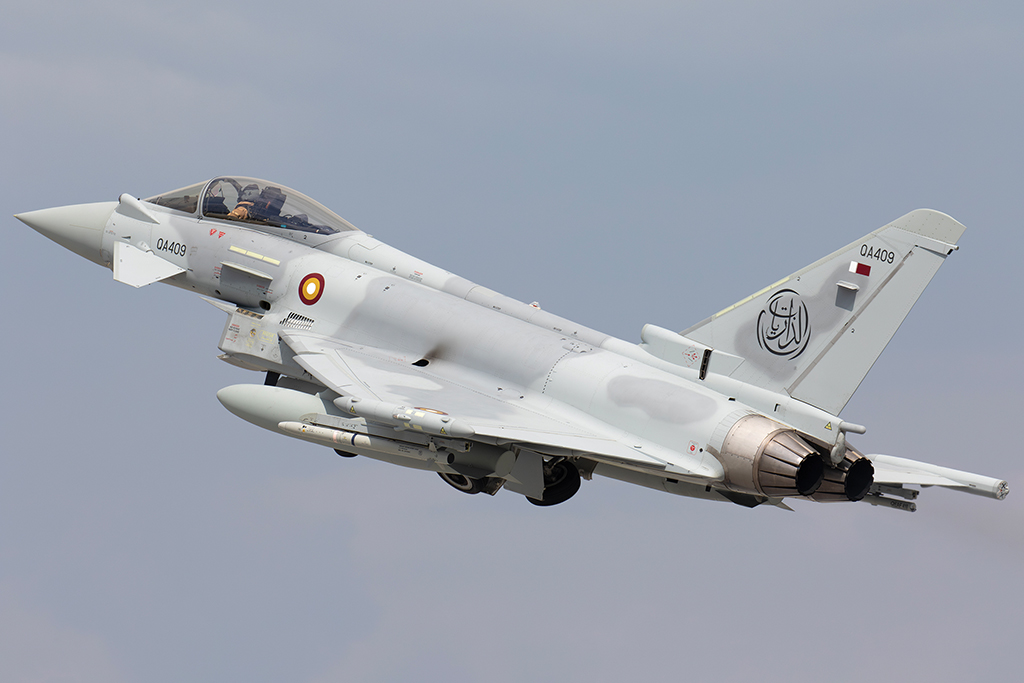Geopolitics, Supply Chain Delays Slow Gulf State Fighter Modernization

Saudi-funded development of the advanced fly-by-wire F-15SA (pictured) has resulted in a renaissance for the Eagle. Now Boeing is hoping to sell the F-15EX there as a replacement for Royal Saudi Air Force F-15C/Ds.
Some countries in the Middle East may have largely settled their combat aircraft plans, but regional turmoil, geopolitics and the supply chain appear to be challenging deliveries and holding up modernization programs.
Across the region, air forces are growing fleets and boosting capabilities—exponentially, in the case of Qatar—in recognition of the threat posed by Iran and its proxies. The moves are perhaps also an acknowledgment that the U.S.—despite ongoing events in Israel and Gaza—is pivoting away from the region to focus on the Pacific and Europe following Russia’s invasion of Ukraine.
- The region’s air forces take an expeditionary approach to fighter operations
- Embargoes and relations with Washington affect Saudi combat aircraft plans
- Political instability delays Kuwaiti Super Hornet deliveries
Today, Gulf state air forces are no longer simply a tool for national defense or a means of displaying muscle to neighbors. Increasingly, they are being used for expeditionary operations as well.
In October, Saudi Boeing F-15SA Eagles operated alongside Turkish Lockheed Martin F-16s and Pakistani Chengdu J-10s and JF-17s for the Pakistani Indus Shield Exercise, and Qatar deployed several of its Eurofighter Typhoons in May to Turkey’s Anatolian Eagle drills, where they operated alongside F-16E/Fs from the United Arab Emirates (UAE). The UAE has deployed its Mirages to Egypt for operations in Libya, too, and a Saudi-led coalition brought together aircraft from across the Gulf Cooperation Council for operations in Yemen, a conflict Riyadh is now eager to end.
“Middle Eastern countries continue to seek high-end, high-technology capabilities,” Douglas Barrie, senior fellow for military aerospace at the London-based International Institute for Strategic Studies, tells Aviation Week.
The most advanced fighters, such as the Lockheed Martin F-35, are still closed off to many regional players, so a number of them are turning to the next-best thing: more advanced variants of fourth-generation platforms. European combat aircraft often enjoy significant sales in the region because they come with weapon packages that include standoff cruise missiles the U.S. is reluctant to provide.
Barrie notes there are questions about how easily these nations can grow their air forces, as some in the region—for example, Saudi Arabia—remain heavily dependent on support from contractors such as BAE Systems.
With the largest air force in the region, Saudi Arabia is continuing its fighter modernization, moving toward what appears to be a two-type fleet made up of Boeing’s F-15 in various versions and the Eurofighter Typhoon. The Panavia Tornado is likely to leave the fleet by the end of the decade in line with the remaining European operators, Germany, and Italy.
Boeing has delivered all of Riyadh’s F-15SAs, the modernized fly-by-wire version of the aircraft that has helped to renew the Eagle’s export opportunities and led to the development of the F-15EX being purchased by the U.S.
But uncertainty surrounds the conversion process of the Royal Saudi Air Force’s F-15S fleet—a downgraded F-15E Strike Eagle variant purchased in the early 1990s—and its conversion to the F-15SR standard, due to several apparent upheavals associated with Alsalam Aerospace Industries, which is performing the work. Among these challenges is that Alsalam is transitioning to new management as it moves under the umbrella of Saudi Arabian Military Industries, the conglomerate that will run much of Saudi Arabia’s defense industry and joint ventures.
Another disruption may follow, as the site at Riyadh’s King Khalid International Airport where Alsalam performs the conversion work now sits inside the planned site of the new giant King Salman International Airport, announced by Crown Prince Mohammed bin Salman last November. This development is expected to force Alsalam to relocate before the work on F-15SRs is complete. Aviation Week analysts conservatively estimate that about 30 of the 68 F-15Ss believed to be still operational have been converted to the F-15SR standard, and others are in the conversion process.
Meanwhile, the Royal Saudi Air Force continues to operate nearly 80 F-15C/D Eagles on air defense tasks. Riyadh appears to be seeking a replacement for them, possibly with the F-15EX, Eurofighter or Dassault Rafale. French media reports suggest France is trying to market the Rafale to the kingdom, even though Saudi Arabia has no experience operating French combat aircraft.
Paris may have spotted an opportunity, however—purchases of the F-15EX appear unlikely, given the current tense relations between Riyadh and Washington. Just two Foreign Military Sales requests from Saudi Arabia have been approved over the last two years, primarily for defensive equipment including missiles for the country’s Patriot batteries.
UK efforts to sell an additional batch of 48 Eurofighters to Saudi Arabia are being challenged by partner nation Germany, whose unilateral arms embargo on new defense sales continues (see page 42). British Prime Minister Rishi Sunak has stepped in to try to resolve the issue by directly lobbying German Chancellor Olaf Scholz, but so far that has not been successful due to disagreements in Scholz’s coalition. The UK side argues that the sale is essential to securing investment and retaining key skills and capabilities to support development of the Global Combat Air Program (GCAP) with Italy and Japan.
The UK and Saudi Arabia are partnering on a feasibility study, due for completion in March, into how the two countries will position what officials describe as their “decadeslong combat air relationship for the future.” Saudi Arabia would like to become a partner on GCAP, an effort that would help fulfill its Vision 2030 ambitions. Saudi officials have lobbied the other partner nations, but Riyadh’s still fledging aerospace and defense industry is unlikely to be able to contribute much to the program at this stage, apart from its deep pockets.
In the UAE, plans for procurement of the Lockheed Martin F-35 Joint Strike Fighter remain on ice because of disagreements with Washington over China-UAE relations—officials in Abu Dhabi appearing not to want their trade relations dictated by the U.S. In response, the Emiratis elected to purchase Hongdu L-15 jet trainers, sealing the deal at the International Defence Exhibition & Conference in Abu Dhabi in February.
The first Emirati L-15s are destined for use by the UAE’s Al Fursan display team, industry sources say, to replace their Aermacchi MB-339s. It is not clear whether Abu Dhabi has decided to take up options for 36 additional L-15s.
All eyes at the Dubai Airshow will be on the progression of the UAE’s order for 80 Dassault Rafales, the largest contract yet for the French fighter. The Emiratis placed the first payments for the Rafales in April 2022. The type will likely replace the country’s well-used Mirage 2000-9s and supplement a similarly sized fleet of Block 60 F-16E/Fs. The UAE also has shown interest in Korea Aerospace Industries’ new indigenous KF-21 Boramae.

Neighboring Qatar now has received most of the three types of fighter aircraft it has ordered from France, the UK and the U.S. Deliveries of 36 Dassault Rafales and 36 Boeing F-15QA Qatari Advanced “Ababil” Eagles have been completed, while deliveries of the Eurofighter Typhoons are continuing.
Defense OEMs hope Qatari’s fighter requirements will rise further. Boeing is contracted to deliver 12 more F-15QAs, officials said at the U.S. Air Force Association Air, Space and Cyber convention in September, bringing Qatar’s F-15 fleet to 48. That number aligns with statements previously made by the U.S. Air Force Security Assistance and Cooperation Directorate, which contracted to build the infrastructure to house the F-15QAs at Al-Udeid AB.
In Kuwait, political instability has been holding up the introduction of new fighters to replace its McDonnell Douglas F/A-18C/D Hornets. Deliveries of the country’s 28 new Block 3 Boeing F/A-18E/F Super Hornets, originally due in the first half of this year, are now expected in the first half of 2024. The aircraft are complete and have been delivered to the U.S. Navy by Boeing; they are in storage in hangars at the Stennis International Airport in Mississippi.
Deliveries of Kuwait’s new Eurofighters are also moving slowly. Nine of the 28 aircraft have been delivered by Italy’s Leonardo, with another four to come shortly. However, Leonardo officials told Aviation Week in a statement that Kuwait’s Typhoon training unit is fully operational, as is the new infrastructure at Ali Al Salem AB.
For Bahrain and Jordan, new fighter capability will come in the form of Block 70 F-16s, albeit later than planned after Lockheed Martin struggled to reestablish F-16 production in North Carolina. The OEM has rolled out at least two of the 16 Vipers for Bahrain, and first deliveries are planned for 2024. Jordan, meanwhile, has placed formal orders for 12 Block 70 F-16s to join the Block 20 fleet it acquired second-hand.
Across the Gulf, Iran appears to be preparing for new fighters, possibly the result of its newly strengthened relations with Russia following deliveries of Iranian one-way attack drones for use in Ukraine. In September Iranian media published images of two Yakovlev Yak-130 advanced jet trainers supplied by Russia, and defense observers have suggested delivery of the trainers could be a precursor of Iran receiving new advanced fighters, possibly Sukhoi Su-35s. The Yak-130s are the first imported combat-capable aircraft delivered into the country since the imposition of the 2006-20 United Nations arms embargo.
Iran’s neighbors will no doubt be following the next steps with interest.
